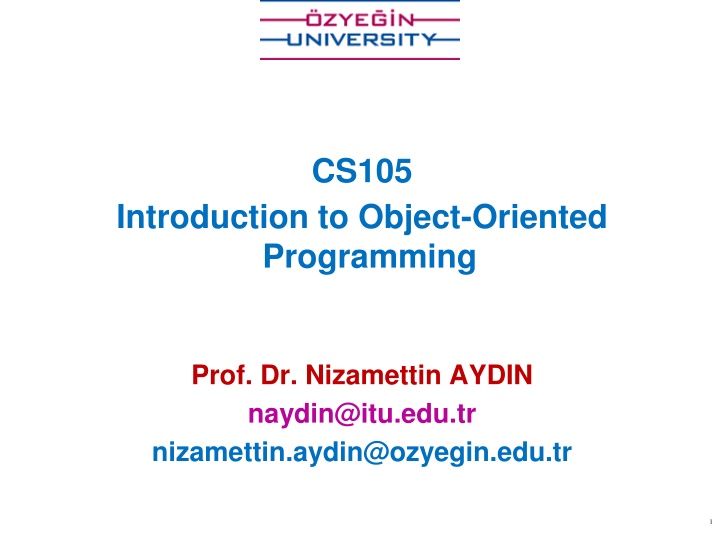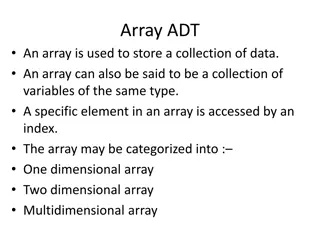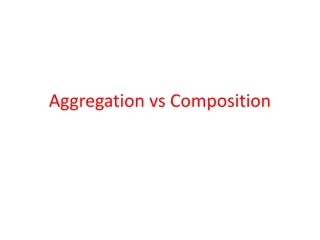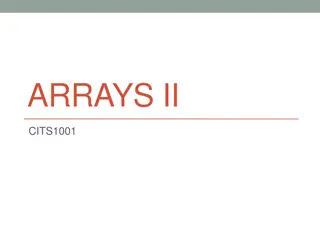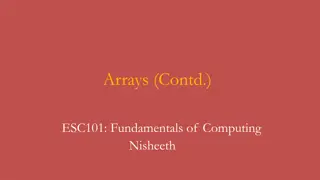Introduction to Object-Oriented Programming with ArrayLists and Arrays
This course covers the fundamentals of object-oriented programming, focusing on ArrayLists and Arrays. Explore topics such as declaring and allocating arrays, initializing array elements, and utilizing ArrayList class methods. Gain insights into array operations, memory allocation, and array manipulation techniques. Dive into the world of Java programming with practical examples and hands-on exercises to enhance your OOP skills.
Download Presentation

Please find below an Image/Link to download the presentation.
The content on the website is provided AS IS for your information and personal use only. It may not be sold, licensed, or shared on other websites without obtaining consent from the author.If you encounter any issues during the download, it is possible that the publisher has removed the file from their server.
You are allowed to download the files provided on this website for personal or commercial use, subject to the condition that they are used lawfully. All files are the property of their respective owners.
The content on the website is provided AS IS for your information and personal use only. It may not be sold, licensed, or shared on other websites without obtaining consent from the author.
E N D
Presentation Transcript
CS105 Introduction to Object-Oriented Programming Prof. Dr. Nizamettin AYDIN naydin@itu.edu.tr nizamettin.aydin@ozyegin.edu.tr 1
Outline Arrays Declaring and Allocating Arrays Allocating an Array and Initializing Its Elements Using an Initializer List to Initialize Elements of an Array Calculating the Value to Store in Each Array Element Summing the Elements of an Array Using Histograms to Display Array Data Graphically Using the Elements of an Array as Counters Using Arrays to Analyze Survey Results Passing Arrays to Methods The ArrayList Class The ArrayList Class 3
Arrays Array Group of contiguous memory locations Each memory location has same name Each memory location has same type c[ 0 ] -45 6 0 72 1543 -89 0 62 -3 1 6453 78 c[ 1 ] c[ 2 ] c[ 3 ] Name of array (Note that all elements of this array have the same name, c) c[ 4 ] c[ 5 ] c[ 6 ] c[ 7 ] A 12-element array. c[ 8 ] c[ 9 ] Position number (index of subscript) of the element within array c c[ 10 ] c[ 11 ] 4
Arrays Subscript Also called an index Position number in square brackets Must be integer or integer expression a = 5; b = 6; c[ a + b ] += 2; Adds 2 to c[ 11 ] Subscripted array name is an lvalue Examine array c c is the array name c.length accesses array c s length c has 12 elements ( c[0], c[1], c[11] ) The value of c[0] is 45 The brackets ([]) are in highest level of precedence in Java 5
Arrays Precedence and associavity of the operators 6
Declaring and Allocating Arrays Declaring and Allocating arrays Arrays are objects that occupy memory Allocated dynamically with operator new int c[] = new int[ 12 ]; Equivalent to int c[]; // declare array c = new int[ 12 ]; // allocate array We can allocate arrays of objects too String b[] = new String[ 100 ]; 7
Allocating an Array and Initializing Its Elements 1 // Fig. 7.3: InitArray.java 2 // Creating an array. 3 4 // Java extension packages 5 import javax.swing.*; 6 7 public class InitArray { 8 9 // main method begins execution of Java application 10 public static void main( String args[] ) 11 { 12 int array[]; // declare reference to an array 13 14 array = new int[ 10 ]; // dynamically allocate array 15 16 String output = "Subscript\tValue\n"; 17 18 // append each array element's value to String output 19 for ( int counter = 0; counter < array.length; counter++ ) 20 output += counter + "\t" + array[ counter ] + "\n"; 21 22 JTextArea outputArea = new JTextArea(); 23 outputArea.setText( output ); 24 25 JOptionPane.showMessageDialog( null, outputArea, 26 "Initializing an Array of int Values", 27 JOptionPane.INFORMATION_MESSAGE ); 28 29 System.exit( 0 ); 30 } 31 } Declare array as an array of ints InitArray.java Line 12 Declare array as an array of ints Allocate 10 ints for array; each int is initialized to 0 by default Line 14 Allocate 10 ints for array; each int is initialized to 0 by default array.length returns length of array Line 19 array.length returns length of array Line 20 array[counter ] returns int associated with index in array array[counter] returns int associated with index in array 8
Allocating an Array and Initializing Its Elements Each int is initialized to 0 by default 9
Using an Initializer List to Initialize Elements of an Array Initialize array elements Use initializer list Items enclosed in braces ({}) Items in list separated by commas int n[] = { 10, 20, 30, 40, 50 }; Creates a five-element array Subscripts of 0, 1, 2, 3, 4 Do not need operator new 10
Using an Initializer List to Initialize Elements of an Array 1 // Fig. 7.4: InitArray.java 2 // Initializing an array with a declaration. 3 4 // Java extension packages 5 import javax.swing.*; 6 7 public class InitArray { 8 9 // main method begins execution of Java application 10 public static void main( String args[] ) 11 { 12 // initializer list specifies number of elements and 13 // value for each element 14 int array[] = { 32, 27, 64, 18, 95, 14, 90, 70, 60, 37 }; 15 16 String output = "Subscript\tValue\n"; 17 18 // append each array element's value to String output 19 for ( int counter = 0; counter < array.length; counter++ ) 20 output += counter + "\t" + array[ counter ] + "\n"; 21 22 JTextArea outputArea = new JTextArea(); 23 outputArea.setText( output ); 24 25 JOptionPane.showMessageDialog( null, outputArea, 26 "Initializing an Array with a Declaration", 27 JOptionPane.INFORMATION_MESSAGE ); 28 29 System.exit( 0 ); 30 } 31 } Declare array as an array of ints InitArray.java Line 14 Declare array as an array of ints Compiler uses initializer list to allocate array Line 14 Compiler uses initializer list to allocate array 11
Using an Initializer List to Initialize Elements of an Array Each array element corresponds to element in initializer list 12
Calculating the Value to Store in Each Array Element Calculate value stored in each array element Initialize elements of 10-element array to even integers 13
1 // Fig. 7.5: InitArray.java 2 // Initialize array with the even integers from 2 to 20. 3 4 // Java extension packages 5 import javax.swing.*; 6 7 public class InitArray { 8 9 // main method begins execution of Java application 10 public static void main( String args[] ) 11 { 12 final int ARRAY_SIZE = 10; 13 int array[]; // reference to int array 14 15 array = new int[ ARRAY_SIZE ]; // allocate array 16 17 // calculate value for each array element 18 for ( int counter = 0; counter < array.length; counter++ ) 19 array[ counter ] = 2 + 2 * counter; 20 21 String output = "Subscript\tValue\n"; 22 23 for ( int counter = 0; counter < array.length; counter++ ) 24 output += counter + "\t" + array[ counter ] + "\n"; 25 26 JTextArea outputArea = new JTextArea(); 27 outputArea.setText( output ); 28 29 JOptionPane.showMessageDialog( null, outputArea, 30 "Initializing to Even Numbers from 2 to 20", 31 JOptionPane.INFORMATION_MESSAGE ); 32 33 System.exit( 0 ); 34 } 35 } Declare array as an array of ints InitArray.java Allocate 10 ints for array Line 13 Declare array as an array of ints Line 15 Allocate 10 ints for array Line 19 Use array subscript to assign array value Use array subscript to assign array value 14
Summing the Elements of an Array Array elements Can represent a series of values We can sum these values 16
1 // Fig. 7.6: SumArray.java 2 // Total the values of the elements of an array. 3 4 // Java extension packages 5 import javax.swing.*; 6 7 public class SumArray { 8 9 // main method begins execution of Java application 10 public static void main( String args[] ) 11 { 12 int array[] = { 1, 2, 3, 4, 5, 6, 7, 8, 9, 10 }; 13 int total = 0; 14 15 // add each element's value to total 16 for ( int counter = 0; counter < array.length; counter++ ) 17 total += array[ counter ]; 18 19 JOptionPane.showMessageDialog( null, 20 "Total of array elements: " + total, 21 "Sum the Elements of an Array", 22 JOptionPane.INFORMATION_MESSAGE ); 23 24 System.exit( 0 ); 25 } 26 } SumArray.java Line 12 Declare array with initializer list Declare array with initializer list Line 17 Sum all array values Sum all array values 17
Using Histograms to Display Array Data Graphically Present array values graphically Histogram Plot each numeric value as bar of asterisks (*) 18
1 // Fig. 7.7: Histogram.java 2 // Histogram printing program. 3 4 // Java extension packages 5 import javax.swing.*; 6 7 public class Histogram { 8 9 // main method begins execution of Java application 10 public static void main( String args[] ) 11 { 12 int array[] = { 19, 3, 15, 7, 11, 9, 13, 5, 17, 1 }; 13 14 String output = "Element\tValue\tHistogram"; 15 16 // for each array element, output a bar in histogram 17 for ( int counter = 0; counter < array.length; counter++ ) { 18 output += 19 "\n" + counter + "\t" + array[ counter ] + "\t"; 20 21 // print bar of asterisks 22 for ( int stars = 0; stars < array[ counter ]; stars++ ) 23 output += "*"; 24 } 25 26 JTextArea outputArea = new JTextArea(); 27 outputArea.setText( output ); 28 29 JOptionPane.showMessageDialog( null, outputArea, 30 "Histogram Printing Program", 31 JOptionPane.INFORMATION_MESSAGE ); 32 33 System.exit( 0 ); 34 } 35 } Declare array with initializer list Histogram.java Line 12 Declare array with initializer list Line 23 For each array element, print associated number of asterisks For each array element, print associated number of asterisks 19
Using the Elements of an Array as Counters Use series of counters to summarize data Array can store these counters 21
1 // Fig. 7.8: RollDie.java 2 // Roll a six-sided die 6000 times 3 4 // Java extension packages 5 import javax.swing.*; 6 7 public class RollDie { 8 9 // main method begins execution of Java application 10 public static void main( String args[] ) 11 { 12 int face, frequency[] = new int[ 7 ]; 13 14 // roll die 6000 times 15 for ( int roll = 1; roll <= 6000; roll++ ) { 16 face = 1 + ( int ) ( Math.random() * 6 ); 17 18 // use face value as subscript for frequency array 19 ++frequency[ face ]; 20 } 21 22 String output = "Face\tFrequency"; 23 24 // append frequencies to String output 25 for ( face = 1; face < frequency.length; face++ ) 26 output += "\n" + face + "\t" + frequency[ face ]; 27 28 JTextArea outputArea = new JTextArea(); 29 outputArea.setText( output ); 30 31 JOptionPane.showMessageDialog( null, outputArea, 32 "Rolling a Die 6000 Times", 33 JOptionPane.INFORMATION_MESSAGE ); 34 Declare frequency as array of 7 ints RollDie.java Line 12 Declare frequency as array of 7 ints Generate 6000 random integers in range 1-6 Lines 15-16 Generate 6000 random integers in range 1-6 Line 19 Increment frequency values at index associated with random number Increment frequency values at index associated with random number 22
Using the Elements of an Array as Counters RollDie.java System.exit( 0 ); 35 36 37 } } 23
Using Arrays to Analyze Survey Results Problem statement 40 students rate the quality of food 1-10 Rating scale: 1 mean awful, 10 means excellent Place 40 responses in array of integers Summarize results 24
1 // Fig. 7.9: StudentPoll.java 2 // Student poll program 3 4 // Java extension packages 5 import javax.swing.*; 6 7 public class StudentPoll { 8 9 // main method begins execution of Java application 10 public static void main( String args[] ) 11 { 12 int responses[] = { 1, 2, 6, 4, 8, 5, 9, 7, 8, 10, 13 1, 6, 3, 8, 6, 10, 3, 8, 2, 7, 14 6, 5, 7, 6, 8, 6, 7, 5, 6, 6, 15 5, 6, 7, 5, 6, 4, 8, 6, 8, 10 }; 16 int frequency[] = new int[ 11 ]; 17 18 // for each answer, select value of an element of 19 // responses array and use that value as subscript in 20 // frequency array to determine element to increment 21 for ( int answer = 0; answer < responses.length; answer++ ) 22 ++frequency[ responses[ answer ] ]; 23 24 String output = "Rating\tFrequency\n"; 25 26 // append frequencies to String output 27 for ( int rating = 1; rating < frequency.length; rating++ ) 28 output += rating + "\t" + frequency[ rating ] + "\n"; 29 30 JTextArea outputArea = new JTextArea(); 31 outputArea.setText( output ); 32 33 JOptionPane.showMessageDialog( null, outputArea, 34 "Student Poll Program", 35 JOptionPane.INFORMATION_MESSAGE ); Declare responses as array to store 40 responses Declare frequency as array of 11 int and ignore the first element StudentPoll.java Lines 12-15 Declare responses as array to store 40 responses Line 16 Declare frequency as array of 11 int and ignore the first element For each response, increment frequency values at index associated with that response Lines 21-22 For each response, increment frequency values at index associated with that response 25
Using Arrays to Analyze Survey Results StudentPoll.java 36 37 38 39 } System.exit( 0 ); } 26
Using Arrays to Analyze Survey Results Some additional points When looping through an array Subscript should never go below 0 Subscript should be less than total number of array elements When invalid array reference occurs Java generates ArrayIndexOutOfBoundsException This is relevant to exception handling 27
Passing Arrays to Methods To pass array argument to a method Specify array name without brackets Array hourlyTemperatures is declared as int hourlyTemperatures = new int[ 24 ]; The method call modifyArray( hourlyTemperatures ); Passes array hourlyTemperatures to method modifyArray 28
Passing Arrays to Methods 1 // Fig. 7.10: PassArray.java 2 // Passing arrays and individual array elements to methods 3 4 // Java core packages 5 import java.awt.Container; 6 7 // Java extension packages 8 import javax.swing.*; 9 10 public class PassArray extends JApplet { 11 12 // initialize applet 13 public void init() 14 { 15 JTextArea outputArea = new JTextArea(); 16 Container container = getContentPane(); 17 container.add( outputArea ); 18 19 int array[] = { 1, 2, 3, 4, 5 }; 20 21 String output = 22 "Effects of passing entire array by reference:\n" + 23 "The values of the original array are:\n"; 24 25 // append original array elements to String output 26 for ( int counter = 0; counter < array.length; counter++ ) 27 output += " " + array[ counter ]; 28 29 modifyArray( array ); // array passed by reference 30 31 output += "\n\nThe values of the modified array are:\n"; 32 33 // append modified array elements to String output 34 for ( int counter = 0; counter < array.length; counter++ ) 35 output += " " + array[ counter ]; PassArray.java Line 19 Declare 5-int array with initializer list Declare 5-int array with initializer list Line 29 Pass array by reference to method modifyArray Pass array by reference to method modifyArray 29
Passing Arrays to Methods 36 37 38 39 40 41 42 43 44 45 46 47 48 49 50 51 52 53 54 55 56 57 58 59 60 61 62 } // end class PassArray output += "\n\nEffects of passing array " + "element by value:\n" + "a[3] before modifyElement: " + array[ 3 ]; PassArray.java Line 42 Pass array[3] by value to method modifyElement Pass array[3] by value to method modifyElement // attempt to modify array[ 3 ] modifyElement( array[ 3 ] ); output += "\na[3] after modifyElement: " + array[ 3 ]; outputArea.setText( output ); Lines 50-54 Method modifyArray manipulates the array directly Method modifyArray manipulates the array directly } // end method init // multiply each element of an array by 2 public void modifyArray( int array2[] ) { for ( int counter = 0; counter < array2.length; counter++ ) array2[ counter ] *= 2; } Lines 57-60 Method modifyElement manipulates a primitive s copy Method modifyElement manipulates a primitive s copy // multiply argument by 2 public void modifyElement( int element ) { element *= 2; } Lines 59 The original primitive is left unmodified The original primitive is left unmodified 30
Passing Arrays to Methods PassArray.java The object passed-by- reference is modified The object passed-by- reference is modified The primitive passed-by-value is unmodified The primitive passed-by- value is unmodified 31
The ArrayList Class Arrays are conceptually important as a data structure, they are not used as much in Java as they are in most other languages. The reason is that the java.util package includes a class called ArrayList that provides the standard array behavior along with other useful operations. ArrayList is a Java class rather than a special form in the language. So, all operations on ArrayLists are indicated using method calls. For example, the most obvious differences include: You create a new ArrayList by calling the ArrayList constructor. You get the number of elements by calling the size method rather than by selecting a length field. You use the get and set methods to select individual elements. the most important methods in the The next slides summarize ArrayList class. The notation <T> indicates the base type. 32
Methods in the ArrayList Class boolean add(<T> element) Adds a new element to the end of the ArrayList; the return value is always true. void add(int index, <T> element) Inserts a new element into the ArrayList before the position specified by index. <T> remove(int index) Removes the element at the specified position and returns that value. boolean remove(<T> element) Removes the first instance of element, if it appears; returns true if a match is found. void clear() Removes all elements from the ArrayList. int size() Returns the number of elements in the ArrayList. <T> get(int index) Returns the object at the specified index. <T> set(int index, <T> value) Sets the element at the specified index to the new value and returns the old value. int indexOf(<T> value) Returns the index of the first occurrence of the specified value, or -1 if it does not appear. boolean contains(<T> value) Returns true if the ArrayList contains the specified value. boolean isEmpty() Returns true if the ArrayList contains no elements. 33
The ArrayList Class int[] array1 = new int[5]; ArrayList<Integer> arrayList1 = new ArrayList<Integer>(); for(int i = 0; i < 5; i++) { array1[i] = i; } for(int i = 0; i < 5; i++) { // add a new element to the end of the list arrayList1.add(i); } 34
The ArrayList Class int[] array1 = new int[5]; for(int i = 0; i < 5; i++) { array1[i] = i; } 0 0 0 0 0 i = 0 0 1 0 0 0 i = 1 0 1 2 0 0 i = 2 0 1 2 3 0 i = 3 0 1 2 3 4 i = 4 35
The ArrayList Class ArrayList<Integer> arrayList1 = new ArrayList<Integer>(); for(int i = 0; i < 5; i++) { // add a new element to the end of the list arrayList1.add(i); } Java Collection classes do not accept primitive types. Instead they use wrapper classes. 36
The ArrayList Class ArrayList<Integer> arrayList1 = new ArrayList<Integer>(); for(int i = 0; i < 5; i++) { // add a new element to the end of the list arrayList1.add(i); } 37
The ArrayList Class ArrayList<Integer> arrayList1 = new ArrayList<Integer>(); for(int i = 0; i < 5; i++) { // add a new element to the end of the list arrayList1.add(i); } 0 i = 0 0 1 i = 1 0 1 2 i = 2 0 1 2 3 i = 3 0 1 2 3 4 i = 4 38
The ArrayList Class int[] array1 = new int[5]; ArrayList<Integer> arrayList1 = new ArrayList<Integer>(); for(int i = 0; i < 5; i++) { array1[i] = i; println(array1.length); } for(int i = 0; i < 5; i++) { // add a new element to the end of the list arrayList1.add(i); println(arrayList1.size()); } 39
The ArrayList Class array[] = 42; println(array[2]); arrayList(2, 42); println(arrayList.get(2)); 40
The ArrayList Class array[] = 42; println(array[2]); arrayList(2, 42); println(arrayList.get(2)); 41
The ArrayList Class ArrayList<Integer> intList = new ArrayList<Integer>(); ArrayList<Double> doubleList = new ArrayList<Double>(); ArrayList<String> stringList = new ArrayList<String>(); intList.add(42); doubleList.add(42.0); stringList.add("42"); Generic Types in Java 5.0: The <T> notation used on the preceding slide is a new feature of Java that was introduced with version 5.0 of the language. In the method descriptions, the <T> notation is a placeholder for the element type used in the array. Class definitions that include a type parameter are called generic types. 44
Generic Types in Java 5.0 The <T> notation used on the preceding slide is a new feature of Java that was introduced with version 5.0 of the language. In the method descriptions, the <T> notation is a placeholder for the element type used in the array. Class definitions that include a type parameter are called generic types. When you declare or create an ArrayList, it is a good idea to specify the element type in angle brackets. For example, to declare and initialize an ArrayList called names that contains elements of type String, you would write ArrayList<String> names = new ArrayList<String>(); 45
Generic Types in Java 5.0 The advantage of specifying the element type is that Java now knows what type of value the ArrayList contains. When you call set, Java can ensure that the value matches the element type. When you call get, Java knows what type of value to expect, eliminating the need for a type cast. 46
